French Proposal on Hold as Tensions Mount
The latest attempt by European powers to salvage the 2015 Iran nuclear deal hit a roadblock this month when the Trump Administration hesitated to engage in a French-sponsored initiative. In August, French President Emmanuel Macron offered a proposal before world leaders at the G-7 summit in Biarritz, France for a $15 billion line of credit to Tehran in exchange for its full compliance with the Joint Comprehensive Plan of Action (JCPOA).
According to the plan, the $15 billion credit line would be guaranteed by Iranian oil and would help compensate Tehran for revenue lost through the reimposition of U.S. sanctions, which began after Washington unilaterally withdrew from the JCPOA in May 2018.
In May 2019, the Trump Administration announced it would not renew the sanctions waivers previously granted to countries importing Iranian oil in what it described as a new approach intended to pressure Iran to give up its uranium enrichment program altogether, curb its missile program, halt its support for proxy forces in the region, and make fundamental changes to its political system.
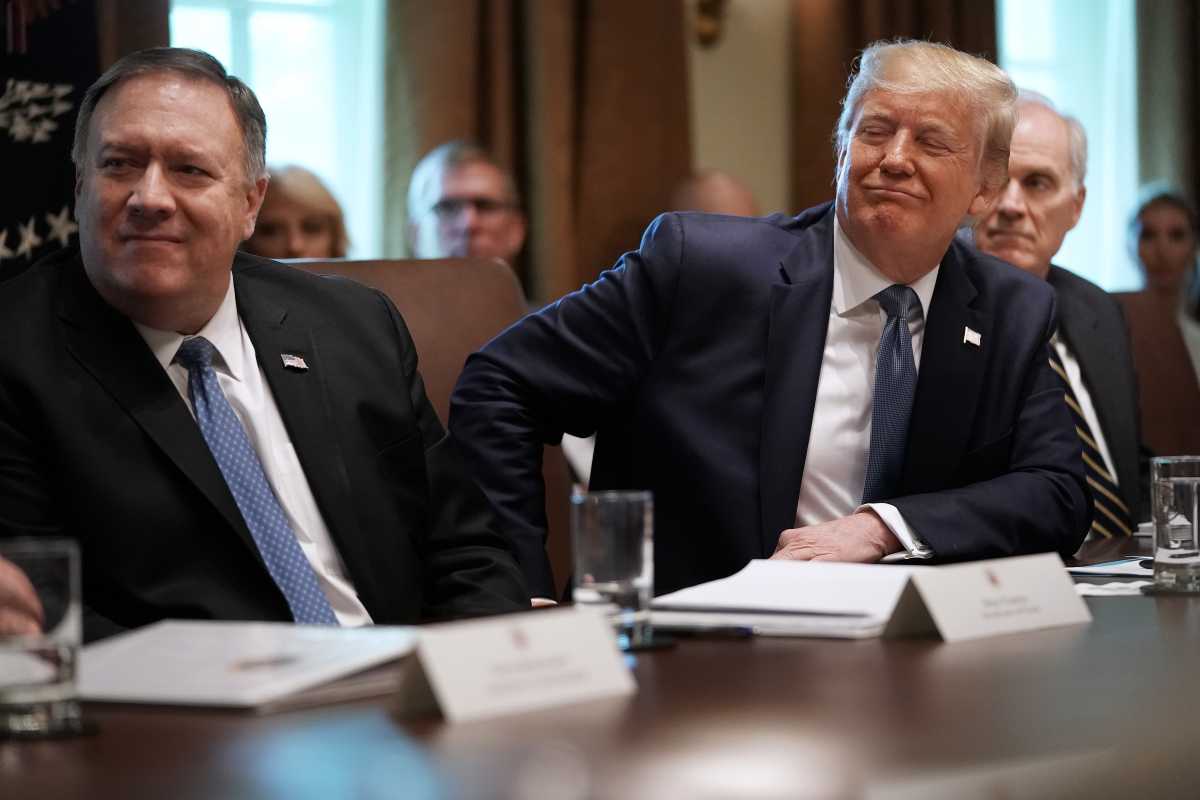 For now, the success of Macron’s initiative, or a variation of it, appears to hinge on whether the Trump Administration will agree to waive sanctions on the relevant oil transfers. So far, U.S. officials are suggesting they won’t.
For now, the success of Macron’s initiative, or a variation of it, appears to hinge on whether the Trump Administration will agree to waive sanctions on the relevant oil transfers. So far, U.S. officials are suggesting they won’t.
The State Department’s coordinator on Iran, Brian Hook, told reporters on Sept. 4 that “We can't make it any more clear that we are committed to this campaign of maximum pressure and we are not looking to grant any exemptions or waivers.”
Without the reissuance of the necessary waivers, France and other countries would likely be unwilling to go forward and risk U.S. Treasury Department enforcement of secondary sanctions on their own institutions. Trump’s approval would not necessarily require U.S. decision to rejoin the JCPOA, but it would allow the other five parties to uphold their obligations under the agreement and under UN Security Council Resolution 2231, which endorses the agreement.
Following the U.S. rebuff of the Macron proposal, Iranian President Hassan Rouhani declared on Sept. 4 that the Islamic Republic would no longer adhere to the limits on uranium centrifuge research and development set by the 2015 Iran nuclear deal, which is its third step away from compliance with the JCPOA in retaliation for the reimposition of U.S. sanctions.
Iran’s announcement that it will ignore centrifuge research and development limits follows its May and July 2019 decisions to exceed caps on uranium stockpile size and uranium enrichment levels.
Iran’s moves are worrisome breaches of the JCPOA, but they are relatively modest and are quickly reversible, and the IAEA confirms Iran is still meeting other JCPOA obligations. This strongly suggests that Iran is not racing to amass weapons-grade nuclear material but is trying to pressure the remaining parties to the JCPOA to deliver the benefits Iran was promised when it agreed to and implemented the multilateral nuclear deal.
On Sept. 4, Iranian state TV reported Iranian President Hassan Rouhani as saying: “I think it is unlikely that we will reach a result with Europe by today or tomorrow. Europe will have another two-month to fulfill its commitments” or else Iran would take further retaliatory steps.
Complicating matters further, the Sept. 14 drone and cruise missile attack on a major Saudi Arabian Oil Co. (Saudi Aramco) oil refinery in eastern Saudi Arabia has increased tensions and, for now, led the Trump administration to double-down on its “maximum pressure” sanctions campaign against Iran. The attack has also diverted European diplomatic efforts away from saving the JCPOA to reducing regional tensions.
This week, world leaders, including Iranian and U.S. officials, will gather for the opening of the UN General Assembly in New York. On Wednesday, Sept. 25, Iranian Foreign Minister Javad Zarif is scheduled to meet ministers from the other nations that agreed to the 2015 nuclear deal, absent the United States, to discuss the JCPOA.
Even after the attack on the Saudi Aramco facility, U.S. Secretary of State Mike Pompeo (who has insisted that Iran must take action in 12 key areas before there will be sanctions relief) has said Trump would be willing to meet “with no preconditions” with Iran's President Hassan Rouhani on the margins of the UN gathering.
Iranian officials have ruled out any such meeting. “No such thing will happen” until the United States “stops economic terrorism and returns to the nuclear deal,” Seyed Abbas Mousavi, a spokesman for the Iranian Foreign Ministry, said Sept. 16.
On Sept. 23, France, Germany and the United Kingdom issued a joint statement that condemns the attack and accused Iran as responsible. The E3 urged de-escalation, incuding a "political solution to ongoing conflict in Yemen," and expressed "continued commitment to the JCPOA." They urged Iran to return to compliance with the nuclear deal and to agree to negotiations "on a long-term framework for its nuclear program" and other regional security issues.
For now, it appears the tit-for-tat spiral of escalation will continue until and unless there is a viable, new diplomatic off-ramp.–DARYL G. KIMBALL, executive director, and JULIA MASTERSON, research assistant
Iran Takes Third Step Away from JCPOA Compliance
In retaliation for the United States’s reimposition of sanctions waived under the terms of the JCPOA, Iran announced on Sept. 4 it is taking a third step away from compliance with the 2015 deal.
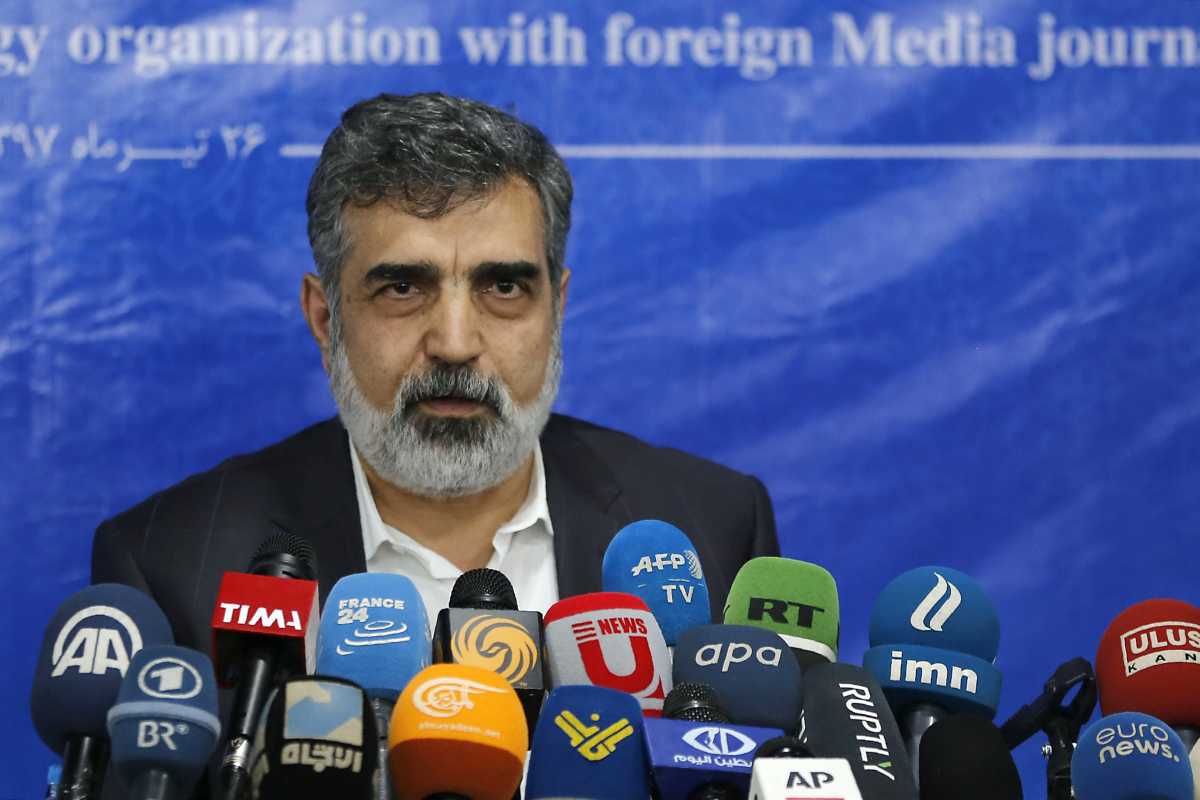 Iranian President Hassan Rouhani on Sept. 4 ordered the atomic energy organization of Iran “to immediately start whatever is needed in the field of research and development, and abandon all the commitments that were in place regarding research and development.” He referred to “expansions in the field of research and development, centrifuges, different types of new centrifuges, and whatever we need for enrichment.”
Iranian President Hassan Rouhani on Sept. 4 ordered the atomic energy organization of Iran “to immediately start whatever is needed in the field of research and development, and abandon all the commitments that were in place regarding research and development.” He referred to “expansions in the field of research and development, centrifuges, different types of new centrifuges, and whatever we need for enrichment.”
Iran’s Atomic Energy Agency spokesman Behrouz Kamalvandi announced on Sept. 6 that technicians had begun introducing uranium hexafluoride gas (UF6) to cascades of 20 IR-4 and 20 IR-6 centrifuges, exceeding the number of machines permitted in a cascade by the Research & Development terms of the nuclear agreement. A Sept. 8 report by the IAEA confirms the installation of advanced centrifuges, which itself is not a violation of the JCPOA.
Kamalvandi, in his announcement, appears to suggest that Iran may soon withdraw enriched uranium from its advanced centrifuges and add it to the stockpile of low enriched uranium, a step which would breach the JCPOA. Under the terms of the nuclear deal, Iran cannot remove and stockpile enriched uranium produced by advanced centrifuges at this time.
Earlier this year, Iran announced that it would breach on its commitments to increase the low-enriched uranium stockpile above the 300-kilogram limit of 3.67 percent enriched uranium and enrich uranium above the 3.67 percent level.
Explainer: The “Macron Plan”
Despite the Trump administration’s effort to dismantle the JCPOA, the other major parties to the deal, particularly France, Germany, the U.K., and the EU, continue to seek to fulfill their commitments and are pressing Iran to keep theirs.
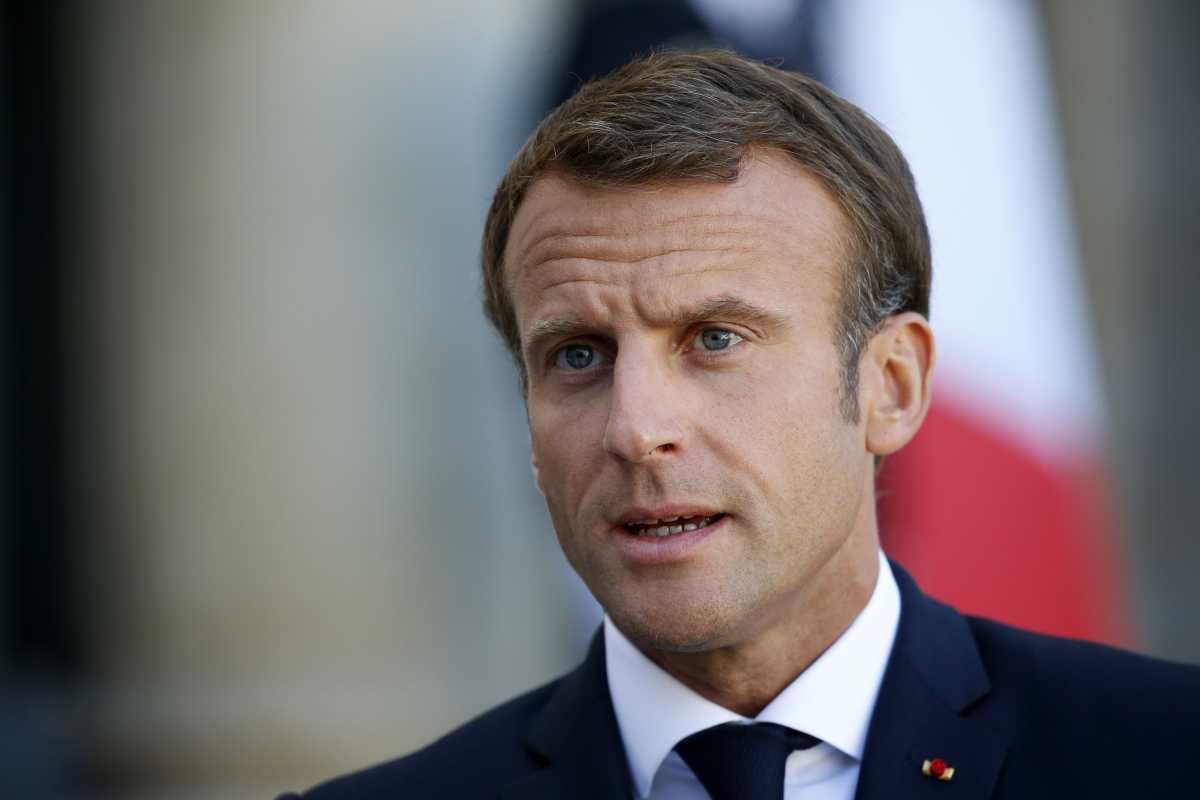 Throughout August and into September, French President Macron and his representatives engaged in talks with Iran on an arrangement that would involve extending Iran a $15 billion line of credit guaranteed by future Iranian oil sales in return for Iran’s return to compliance with the JCPOA and a return to negotiations on regional security and the future of Iran’s nuclear program.
Throughout August and into September, French President Macron and his representatives engaged in talks with Iran on an arrangement that would involve extending Iran a $15 billion line of credit guaranteed by future Iranian oil sales in return for Iran’s return to compliance with the JCPOA and a return to negotiations on regional security and the future of Iran’s nuclear program.
On Sept. 3, French Foreign Minister Jean-Yves le Drian said talks on the credit arrangement, which would be guaranteed by Iranian oil revenues, were continuing, but U.S. approval would be crucial. The idea is “to exchange a credit line guaranteed by oil in return for, one, a return to the JCPOA (Iran nuclear deal) ...and two, security in the Gulf and the opening of negotiations on regional security and a post-2025 (nuclear program),” Le Drian told reporters. “All this (pre)supposes that President Trump issues waivers.”
Many news outlets incorrectly labeled the plan as a “bailout” for Iran. It is not. In reality, the French plan would not provide any new money to Iran.
Instead, the French “plan is designed to provide Iran a financial benefit it was already receiving—in accordance with U.S. sanctions relief—back in 2017” according to an analysis by Esfandyar Batmanghelidj, publisher of the online publication, Bourse & Bazaar.
As Batmanghelidj notes, “.. in 2017, French, Italian, and Spanish refiners were importing around 600,000 barrel per day of Iranian oil on an annual basis,” which has an approximate value of the value of $15 billion (at $58 per barrel of oil).
Earlier this year, the Europeans established INSTEX, a state-owned trade intermediary to facilitate trade in non-sanctioned goods with Iran, but when the U.S. oil sanctions waivers were eliminated in May 2019, oil imports were halted. Only China and Syria continue to buy Iranian oil, albeit at a lessened rate, in defiance of U.S. sanctions.
Thus, Batmanghelidj writes, the Macron plan is “merely seeking permission from the Trump administration to restore their own compliance with the implementation of economic benefits of the JCPOA—a request growing more urgent as Iran loosens its own compliance with its nuclear commitments under the deal.”
Attack on Saudi Aramco Facility Stokes Tensions
Following a major drone and cruise missile attack on a Saudi Aramco oil facility in Saudi Arabia on Sept. 14 officials in Washington D.C. and in Riyadh rejected claims of responsibility by Houthi rebels based in Yemen and placed blame on Iran for the attack.
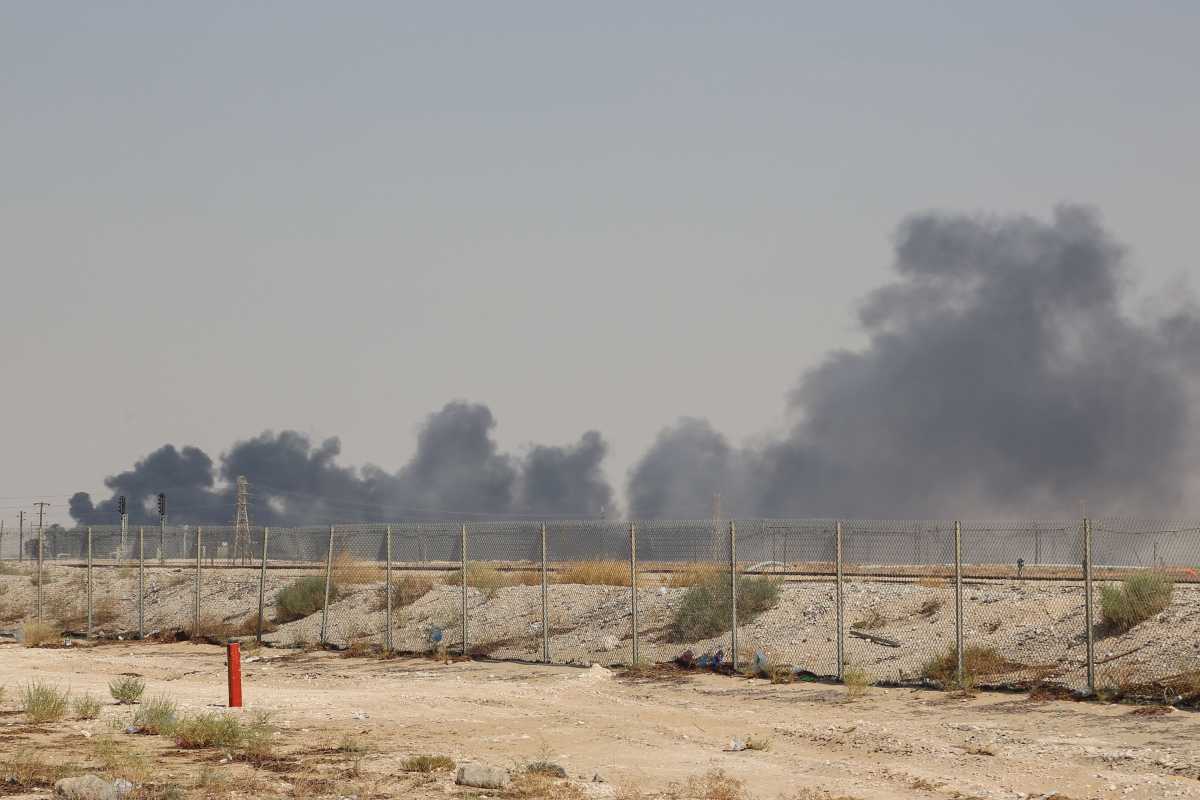 On Sept. 20, Saudi officials shared images of wreckage from the site including scraps of a cruise missile that bears some similarity to Iranian military hardware. United Nations Secretary-General Antonio Guterres announced on Sept. 18 that U.N. inspectors were dispatched to Saudi Arabia to further investigate the attack.
On Sept. 20, Saudi officials shared images of wreckage from the site including scraps of a cruise missile that bears some similarity to Iranian military hardware. United Nations Secretary-General Antonio Guterres announced on Sept. 18 that U.N. inspectors were dispatched to Saudi Arabia to further investigate the attack.
On Sept. 20, Defense Secretary Mark Esper said it was clear that the weapons used in the attack “were Iranian-produced and were not launched from Yemen,” as Iranian-backed Houthi rebels there initially asserted. “All indications are that Iran was responsible,” he said.
The attack on Saudi oil infrastructure initially led some members of the Trump administration to hint at retaliatory measures to “restore deterrence” and help defend Saudi Arabia, which is not a U.S. treaty ally. On Sept. 15, Trump issued an ominous ‘locked and loaded’ tweet implying he was considering a retaliatory strike.
In response, several Democratic lawmakers, including Senators Tim Kaine (D- Va.) and Chris Coons (D- DE), argued that the executive branch would need Congressional backing before ordering military intervention. Iranian Foreign Minister Zarif cautioned that such a measure would prompt an “all-out war.”
In recent days, however, it has become clear that President Trump and his officials will pursue far less substantial measures.
Defense Secretary Esper announced Friday, Sept. 19, the deployment of a small number of U.S. troops to the Kingdom, an act which President Trump authorized in response to the Aramco oil facility strike. The administration is also seeking to accelerate a controversial package of additional arms transfers to Saudi Arabia and the United Arab Emirates.
In response, House Speaker Nancy Pelosi (D-Calif.) issued a statement charging that “President Trump’s plan to accelerate the delivery of military equipment to Saudi Arabia and UAE, and to deploy additional U.S. forces to the region is the latest outrageous attempt by the Trump Administration to circumvent the bipartisan will of Congress.”
The administration has also responded by announcing some additional sanctions would be levied against Iranian entities. On Friday, Sept. 20, the U.S. Department of the Treasury’s Office of Foreign Assets Control (OFAC) sanctioned the Central Bank of Iran, the National Development Fund of Iran, and the Etemad Tejarate Pars Co., an Iranian company implicated in concealing the military’s financial transactions.
In his announcement about the sanctions, Treasury Secretary Mnuchin warned, “Iran’s brazen attack against Saudi Arabia is unacceptable,” and affirmed that the United States would continue with its maximum pressure campaign.
After the IAEA’s Latest Report on Iran’s Program, Questions Linger
In late-August, the Agency issued its latest report on “Verification and monitoring in the Islamic Republic of Iran in light of United Nations Security Council resolution 2231.”
The report indicates that Iran is still in breach of the JCPOA in two areas (increasing the low-enriched uranium stockpile above the 300-kilogram limit of 3.67 percent enriched uranium, and enriching uranium above the 3.67 percent level as stipulated in the JCPOA) but it is in compliance with its JCPOA obligations in all other areas.
Iran’s decision to breach these two JCPOA nuclear limits—and possibly others down the line—is worrisome, but it does not pose a near-term proliferation risk. Iran would still have to quadruple its stockpile of low-enriched uranium and then further enrich it to weapons-grade (greater than 90 percent uranium-235), and then weaponize it to build a bomb. Intrusive International Atomic Energy Agency (IAEA) inspections would provide early warning of any such moves by Iran in these areas.
The latest IAEA report shows that Tehran is not racing toward the bomb but rather, Iran’s leaders are seeking leverage to counter the U.S. pressure campaign, which has systematically denied Iran any benefits of complying with the deal.
Specifically, the IAEA reported that:
- Iran has begun to enrich uranium to levels above 3.67 percent uranium-235 (up to 4.5 percent).
- As previously reported on July 1 2019, the Agency verified that Iran’s total enriched uranium stockpile had exceeded 300 kg of UF6 enriched up to 3.67% U-235 (or the equivalent in different chemical forms). The quantity of 300 kg of UF6 corresponds to 202.8 kg of uranium. As of Aug. 19 2019, the Agency verified that Iran’s total enriched uranium stockpile was 241.6 kg, based on the JCPOA and decisions of the Joint Commission. The stockpile comprised 216.5 kg of uranium enriched up to 3.67% U-235 and 25.1 kg of uranium enriched up to 4.5% U–235.
The IAEA report also noted that:
- Iran is operating no more than 5,060 IR-1 centrifuges at the Fuel Enrichment Plant at Natanz as required by the JCPOA. Since the last IAEA report, Iran withdrew 18 IR-1 centrifuges to replace broken machines.
- Iran is adhering to the limit of 1,044 IR-1 centrifuges installed at the Fordow site and is conducting stable isotope research and development at that facility in line with JCPOA requirement
- Throughout the reporting period, Iran had no more than 130 metric tonnes of heavy water.
- Iran has not carried out activities related to reprocessing at the Tehran Research Reactor (TRR) and the Molybdenum, Iodine and Xenon Radioisotope Production (MIX) Facility or at any of the other facilities it has declared to the Agency.
- Iran has not restarted work on the unfinished heavy-water reactor according to the original (pre-JCPOA) design.
- Iran continues to provisionally implement the additional protocol to its IAEA safeguards agreement.
- Inspectors have had access to all the sites in Iran that they have needed to visit.
The report also indicates that the IAEA is somewhat concerned about the need for Iran to respond to the Agency’s questions about a recent IAEA site visit, which is indirectly referenced in section E.24 in the report.
Shortly after the release of the IAEA report on Iran’s nuclear activities, Acting IAEA Director-General Cornel Feruta traveled to Iran for consultations.
In his Sept. 9 statement to the IAEA General Conference, Feruta said: “Regarding the implementation of Iran’s Safeguards Agreement and the Additional Protocol, during my discussions in Tehran, I emphasized the importance of full and timely cooperation by Iran. It is important to advance our interactions and, therefore, I also stressed the need for Iran to respond promptly to Agency questions related to the completeness of Iran’s safeguards declarations. The Agency will continue its efforts and will remain actively engaged. Time is of the essence.”
The remarks were apparently a reference to questions about samples taken by IAEA inspectors at a facility where equipment and documents from previous nuclear operations are being stored. According to reporting by The Wall Street Journal and Reuters, the Agency found traces of low-enriched uranium that Iran has yet to explain, diplomats who follow the agency’s inspections work closely say.
Tweeting on Sept. 10, U.S. Secretary of State Pompeo condemned Iran’s “lack of cooperation” with the IAEA and argued that Iran’s behavior raised “questions about possible undeclared nuclear material or activities,” strengthening the administration’s denunciation of the nuclear accord.
Without the JCPOA, however, the IAEA would not have been able to gain access to the site to inspect it. Despite Pompeo's charges of lack of cooperation, the acting IAEA chief Cornel Feruta said his exchanges with Iranian officials have been "very substantial" and that he was "pleased with the tone and the input we received."
Netanyahu Levels New Charges Against Iran
Ahead of a very tight national election, Israeli Prime Minister Benjamin Netanyahu alleged on Sept. 8 there is a previously undisclosed Iranian nuclear site that he says was once used to “conduct experiments to develop nuclear weapons.” The Abadeh facility, according to Netanyahu, was demolished after Tehran learned of Israel’s discovery. In his presentation of satellite imagery displaying the dilapidated warehouse, Netanyahu called on the international community to support the Trump administration’s ongoing maximum pressure sanctions campaign and to join the United States in condemning Iran.
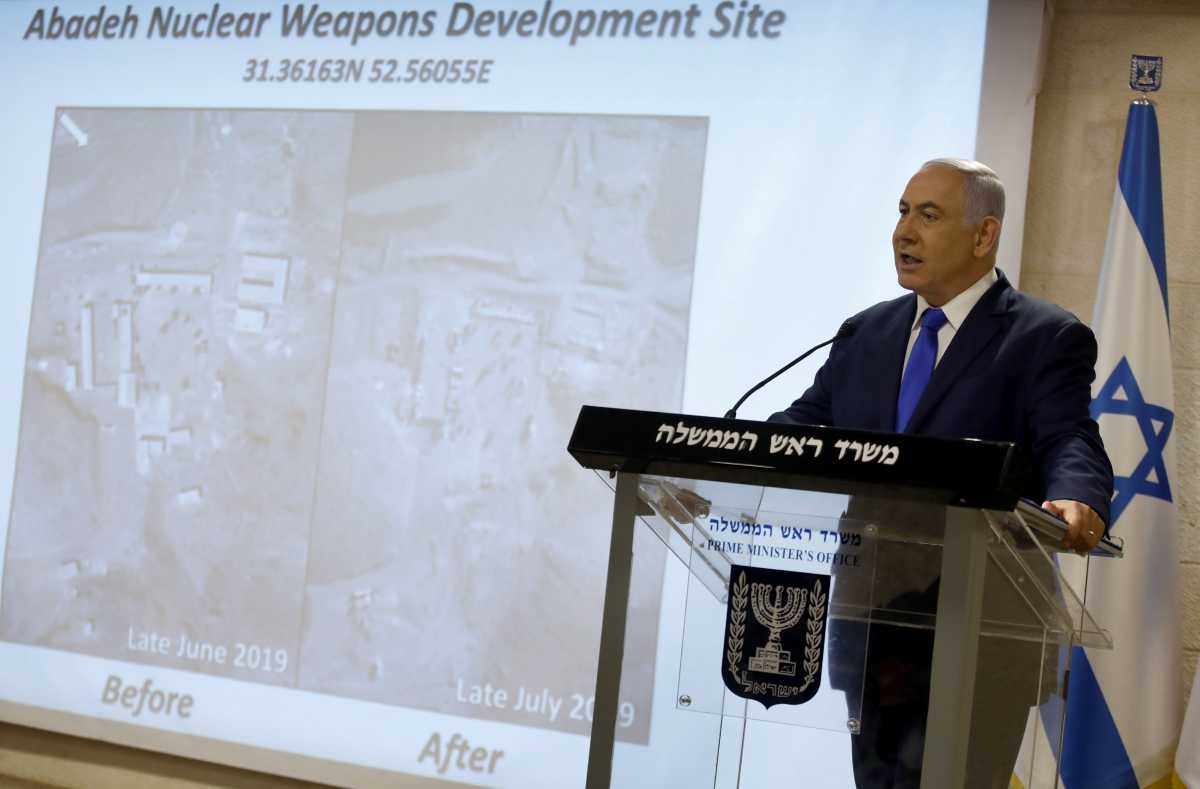 Iranian Foreign Minister Mohammad Javad Zarif pointed out that Israel itself has a secret, but widely known, nuclear program and said on Twitter that "The possessor of REAL nukes cries wolf -- on an alleged 'demolished' site in Iran.”
Iranian Foreign Minister Mohammad Javad Zarif pointed out that Israel itself has a secret, but widely known, nuclear program and said on Twitter that "The possessor of REAL nukes cries wolf -- on an alleged 'demolished' site in Iran.”
Netanyahu’s allegation follows on his revelations in 2018 of Iran’s so-called “Atomic Archive” at a site south of Tehran in Turquzabad raided by Israeli agents in early 2018.
The Trump Administration has expressed support for Netanyahu’s allegation which, if true, would raise further suspicions about Iran’s compliance with its IAEA safeguards obligations.
If any IAEA member-state including the United States or Israel has credible information about noncompliant activities at Abadeh or elsewhere, they are obligated to provide it to the IAEA to facilitate its work to verify compliance.
New IAEA Director-General Will Inherit Complex Iran File
With the death of the International Atomic Energy Agency’s director-general Yukiyo Amano July 18, the agency’s governing body, the 35-member Board of Governors, is engaged in the search for a new Director-General for only the sixth time since it was established in 1957.
The IAEA is primarily charged with regulating the safety and security of nuclear materials and facilities in civilian uses and to verify that nuclear activities principally in non-nuclear-weapon states party to the nuclear Non-Proliferation Treaty--including Iran--are not used for military purposes. Today, the IAEA has a budget of € 592 million a year and a staff of 2,500 staff from over 100 nations.
On Aug. 2, 2019, the Board adopted the procedure for the appointment of a new DG and is expected to appoint a Director-General by the end of October 2019. The new director-general will assume office no later than Jan. 1, 2020.
In 2015, the IAEA completed a multiyear, contentious investigation of Iran’s past nuclear activities, assessing that Iran had indeed conducted nuclear weapons developmental work before 2003 but found no evidence that Iran had continued such efforts after 2009. In 2015, the Agency also concluded an agreement with Iran outlining the Agency’s plan to continue to assess whether such activities continue, or not.
That ongoing inquiry, along with the IAEA’s critical role in monitoring Iran’s nuclear activities on the basis of the enhanced monitoring and verification terms established through the JCPOA, will be a major responsibility for the new director-general and the IAEA team.
Four candidates are in the running to become the director-general:
- Romania nominated Cornel Feruta who currently serves as the IAEA’s acting director-general.
- Burkina Faso nominated Dr. Lassina Zerbo, the two-term executive secretary of the Comprehensive Nuclear-Test-Ban Treaty Organization, based in Vienna.
- Slovakia nominated Marta Ziakova, who is the chair of her country's Nuclear Regulatory Authority.
- Argentina nominated Rafael Grossi, its permanent representative to international organizations in Vienna. He is also the presumptive president of the 2020 nuclear Nonproliferation Treaty Review Conference.
Bolton Departs. But Will It Make a Difference?
President Trump’s 2018 decision to abandon U.S. commitments under the terms of the 2015 multilateral nuclear accord came just weeks after he named longtime JCPOA critic and regime-change proponent John Bolton as his National Security Advisor. Eighteen months later, Trump and Bolton decided to part ways over differences on multiple issues, including Iran policy.
According to a Sept. 14 NBC news report, Trump and John Bolton sparred over lifting Iran sanctions shortly before Trump announced Bolton’s departure. According to the report, “after President Donald Trump suggested he might lift some U.S. sanctions on Iran as an incentive for Tehran to come to the negotiating table, according to a person close to Bolton. This person said Trump raised the idea of lifting sanctions during a discussion with Bolton in the Oval Office Monday afternoon. Bolton made clear to the president that he strongly disagreed with the idea, this person said.”
Bolton’s departure may not lead to any adjustments in the Trump administration’s Iran policies, which so far have not forced changes in Iran’s regional behavior or pushed Iran into accepting new U.S. demands. Since Trump adopted the so-called “maximum pressure” policy and reinstated oil and financial sanctions that had been waived under the terms of the JCPOA, tensions in the Persian Gulf region have increased and Iran’s incentives to continue to respect the nuclear limits set by the JCPOA have decreased.
Newly appointed National Security Advisor Robert C. O’Brien has made statements that suggest his views on Iran and the JCPOA may be just as negative as Bolton’s. In the spring of 2018, he referred to the JCPOA in spring 2018 as “rank appeasement.” and “nothing more than that.”
Depending on how forceful he is in pressing his views and how he manages the interagency policy process, O’Brien may not help facilitate Trump’s apparent interest in reaching a new diplomatic understanding with Iran.
In Case You Missed It…
- “Iranian central bank designation: What does it mean?” by Brian O'Toole, via the New Atlanticist, Sept. 20, 2019
- “Why Iran’s leadership thinks escalation can pay off,” op-ed by Suzanne Maloney, The Washington Post, Sept. 18, 2019
- "Taking a closer look at the Abadeh site," by Fabian Hinz, Arms Control Wonk (blog), Sept. 11, 2019
- “Israeli Leader Says Iran Hid a Nuclear Site,” analysis by David M. Halbfinger and David E. Sanger, The New York Times, Sept. 9, 2019
On the Calendar
| Sept. 16-20 | Meeting of the International Atomic Energy Agency General Conference, Vienna |
| Sept. 25 | Representatives from the P4+1 and Iran meet on the margins of the UN General Assembly in New York |
| Nov. 21-22 | Meeting of the International Atomic Energy Agency Board of Governors, Vienna |
| Nov. 4 | Iran says it will take a fourth step to breach nuclear limits of the JCPOA if the remaining parties to the deal do not take actions necessary to deliver the benefits promised to Iran through sanctions relief. |
